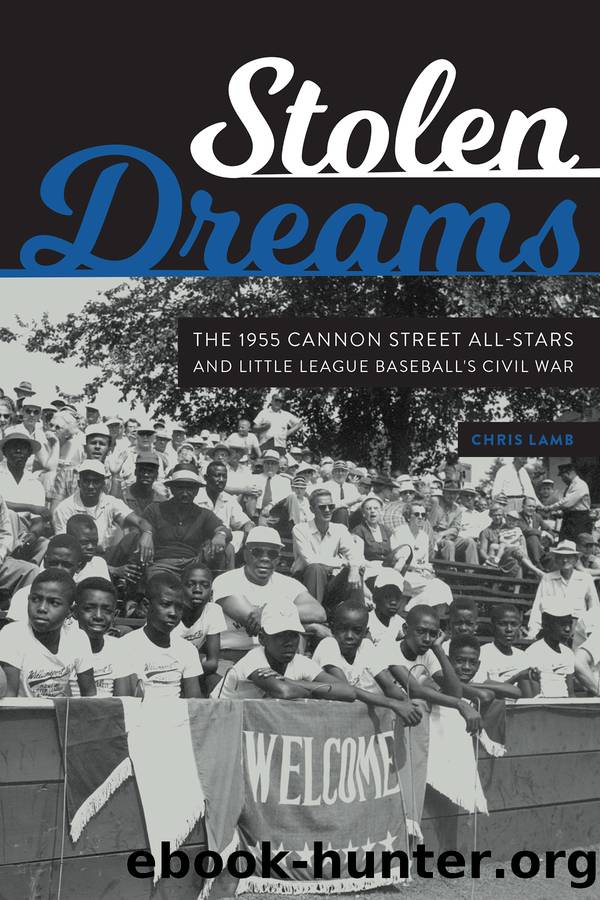Stolen Dreams by Chris Lamb

Author:Chris Lamb [Lamb, Chris]
Language: eng
Format: epub
Tags: SPO003030 Sports & Recreation / Baseball / History, SOC001000 Social Science / Ethnic Studies / African American Studies, SOC031000 Social Science / Discrimination & Race Relations
Publisher: Nebraska
* * *
The opening ceremonies for the eighth Little League World Series began on Tuesday, August 23, with eight teams from San Diego, California; Winchester, Massachusetts; Hamtramck, Michigan; Delaware Township, New Jersey; Glens Falls, New York; Morrisville, Pennsylvania; Auburn, Alabama; and Alexandria, Louisiana. Eighty-eight-year-old Cy Young, the winningest pitcher in Major League history, threw out the first ball. This was the last appearance for Young, who had attended each of the Little League World Series. He died three weeks later. Stotz was one of the pallbearers. Other guests of Little League Baseball included Pennsylvaniaâs governor, George M. Leader, and General George C. Marshall, then secretary of defense.
The press in Williamsport included Ted Husing, who broadcast the game on CBS radio; local sportswriters; wire service reporters; Bob Considine, one of the most famous journalists in the country; and Sam Lacy, of the Baltimore Afro-American, the countryâs best-known sportswriter working for a Black newspaper. Lacy and Considine had known each other since they were teenagers in Washington DC. Both were talented athletes who wanted to be journalists. Lacy remembered when they were playing tennis one day. âSam, you know itâs a shame,â Considine told him. âWhen we grow up, Iâm going to be able to go a lot farther than you.â24 Considine was right. He became one of Americaâs best-paid journalistsâa syndicated newspaper columnist, prolific author, war correspondent, screenwriter, and commentator. Lacy spent his life working for modest wages for African American newspapers. But he became as well known to his readers as Considine was to his.
Lacy, who was born in 1903, grew up in Washington DC near the home of Griffith Stadium, home of the Major League team, the Nationals, who would later change their name to the Senators. Lacyâs father, Sam Sr., a researcher at a law firm, introduced his love of baseball to his son. The two regularly attended games at Griffith Stadium, where they sat in the segregated section in right field.25 When Lacy was a teenager, he began working at Griffith Stadium during Nationalsâ gamesâshagging flies during batting practice before the games and then either selling concessions or operating the scoreboard during the games. When the Nationals were on the road, the teamâs owner, Clark Griffith, leased the stadium to Negro League teams. Lacy, therefore, saw both African American and white teams. He said he saw many African American players who were equal or better than whites in the Major Leagues. This experience shaped his lifelong interest in racial equality. Segregation deprived the best African American players of playing in the big leagues, Lacy said, but it also deprived white players of playing against them and white spectators of watching those players.26
After Lacy attended Howard University, the Washington Tribune hired him to be a staff reporter and promoted him to sports editor. In 1935 Lacy went to see Griffith, who he knew from working at the ballpark, and asked the Senatorsâ owner why African Americans were not in the big leagues. He told Griffith that the perpetually
Download
This site does not store any files on its server. We only index and link to content provided by other sites. Please contact the content providers to delete copyright contents if any and email us, we'll remove relevant links or contents immediately.
| African Americans | Civil War |
| Colonial Period | Immigrants |
| Revolution & Founding | State & Local |
Cat's cradle by Kurt Vonnegut(13903)
Pimp by Iceberg Slim(12952)
Underground: A Human History of the Worlds Beneath Our Feet by Will Hunt(11274)
4 3 2 1: A Novel by Paul Auster(11078)
The Radium Girls by Kate Moore(10924)
American History Stories, Volume III (Yesterday's Classics) by Pratt Mara L(4830)
Perfect Rhythm by Jae(4630)
Wiseguy by Nicholas Pileggi(4606)
The Fire Next Time by James Baldwin(4355)
Paper Towns by Green John(4179)
A Higher Loyalty: Truth, Lies, and Leadership by James Comey(4044)
Pale Blue Dot by Carl Sagan(4021)
The Mayflower and the Pilgrims' New World by Nathaniel Philbrick(3922)
The Doomsday Machine by Daniel Ellsberg(3743)
Too Much and Not the Mood by Durga Chew-Bose(3702)
Killers of the Flower Moon: The Osage Murders and the Birth of the FBI by David Grann(3630)
The Borden Murders by Sarah Miller(3597)
The Sympathizer by Viet Thanh Nguyen(3528)
Killing England by Bill O'Reilly(3467)
